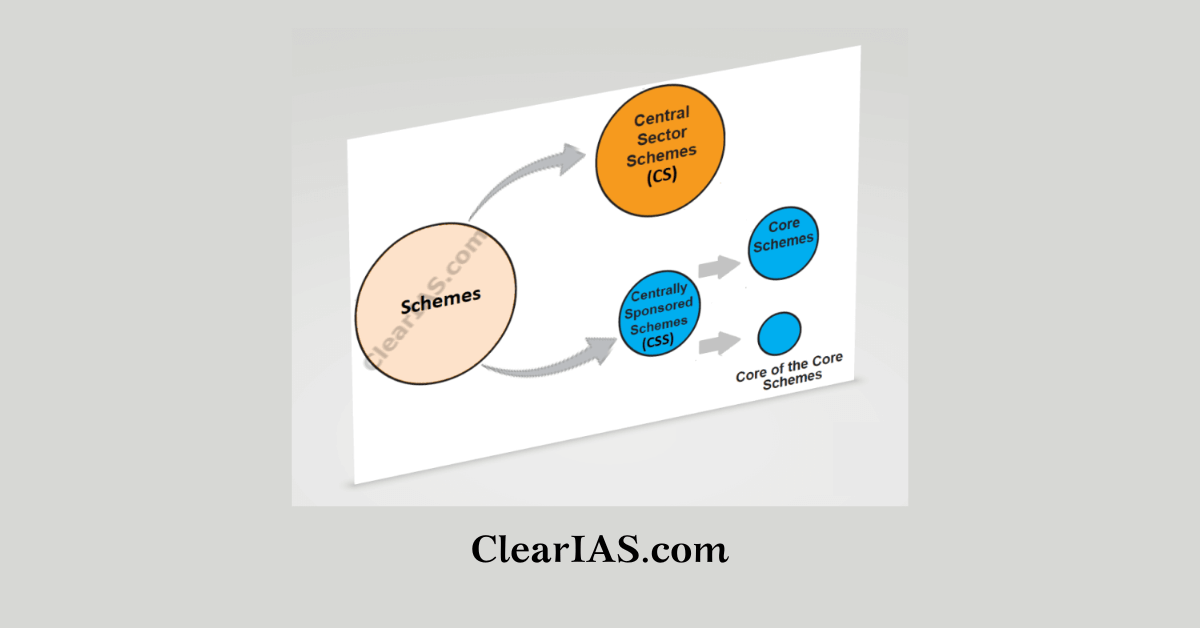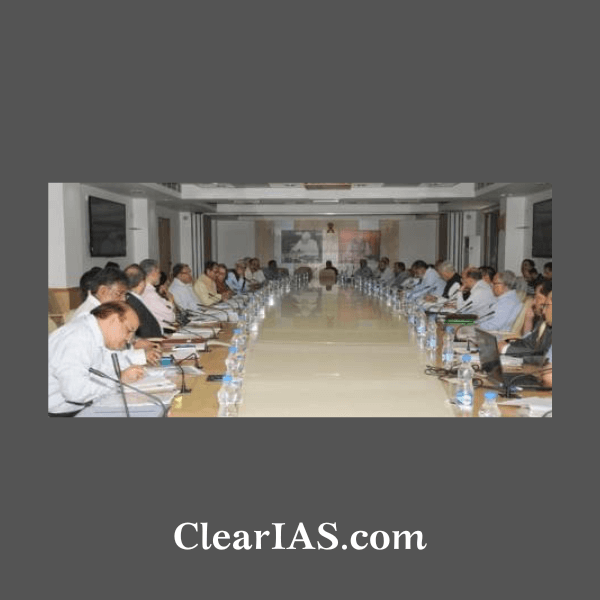
Examples of national goals and objectives include extending clean drinking water and sanitation to every habitation, eradicating polio and tuberculosis, making primary education universal for every female and male child, and so on.
Centrally Sponsored Schemes (CSS) are again divided into Core of the Core Schemes and Core Schemes.
How are Centrally Sponsored Schemes different from Central Sector Schemes?
Centrally Sponsored Schemes are different from Central Sector Schemes in the sense that Central Sector Schemes are implemented by Center directly while Centrally Sponsored Schemes are implemented by states.
CSS are extended by the Union Government to States under Article 282 of the Constitution. The mainly cover items listed in states list.
Centrally Sponsored Schemes vs Central Assistance
Centrally Sponsored Schemes (CSSs) now form a major part of the Central Assistance(CA) given by the centre to states to implement the state plans. For ease of understanding, CSS may now be treated synonymously to CA.
There were other types of Central Assistance before 2015-16, but almost all of them are discontinued as states got higher revenue after the 14th Finance Commission recommendations (higher devolution of taxes to states).
Restructuring of Centrally Sponsored Schemes – Chaturvedi Committee Recommendations (2014)
In 2014, the UPA-2 government approved Planning Commission’s proposal to merge the 147 Centrally Sponsored Schemes (CSS) and bring it down to 66 across various sectors for effective implementation and monitoring of the 12th Five Year Plan. The merger proposal was in line with the recommendations of the Chaturvedi committee, which had suggested bringing down CSS to avoid overlap.
CSS, Flagship Schemes and ACA: CSSs are backed by Central government grant money. They have been implemented by State governments over at least ten Five Year Plans. Out of the Centrally sponsored schemes, Government gives priority to certain special schemes to achieve social objectives. These schemes are called Flagship schemes. Schemes covered under additional central assistance are known as ACA.
Conceptually both CSS and Additional Central Assistance (ACA) Schemes have been passed by the Central Government to the State governments. The difference between the two has arisen because of the historical evolution and the way these are being budgeted and controlled and release of funds takes place. In case of CSS, the budgets are allocated under ministries concerned themselves and the entire process of release is also done by them.
Centrally Sponsored Schemes and Flagship Schemes during UPA-2 regime
Towards the end of the UPA-2 rule (after restructuring), there were 66 Centrally Sponsored Schemes. 17 schemes out of the 66 schemes were called Flagship schemes. Flagship schemes correspond to a few major schemes, with higher fund allocation and rigorously pursued by the Government to achieve its national objectives.
Please see below the list of 66 Centrally Sponsored Schemes (CSS) including the 17 flagship schemes.
66 Centrally Sponsored Schemes (CSS) including the 17 flagship schemes: UPA-2 regime
- Jawaharlal Nehru National Urban Renewal Mission (JNNURM) *.
- Accelerated Irrigation Benefit Programme (AIBP) *.
- National Social Assistance Programme (NSAP) *.
- Rashtriya Krishi Vikas Yojana (RKVY) *.
- Rajiv Gandhi Grameen Vidyutikaran Yojana (RGGVY) *. [Central Sector Scheme]
- Restructured-Accelerated Power Development and Reform Programme (R-APDRP) *. [Central Sector Scheme]
- Backward Regions Grant Fund (BRGF) *.
- National Food Security Mission.
- National Horticulture Mission.
- National Mission on Sustainable Agriculture.
- National Mission on Seeds and Planting Material.
- National Oilseed and Oil Palm Mission.
- National Mission on Farm Mechanization and Energy.
- Managing Livestock.
- National Plan for Dairy Development.
- Development of Fisheries.
- ASIDE.
- Special Package for industrial development of NE & other Special Category States.
- National River Conservation Programme (NRCP).
- Conservation of Natural Resources & Environment Protection.
- Integrated Development of Wildlife.
- Intensification of Forest Management.
- National Rural Health Mission *.
- Non-Communicable Diseases.
- Human Resources and Medical Education.
- National Urban Health Mission.
- District Hospital.
- National Mission on AYUSH.
- National AIDS Control Programme, including STD Control.
- National Scheme for Capacity Development of Police and other forces.
- Swarna Jayanti Shahari Rozgar Yojana (SJSRY)/National Urban Livelihoods Mission (NULM)
- Integrated Low Cost Sanitation (ILCS).
- Sarva Shiksha Abhiyan (SSA) *.
- National Programme Nutritional Support to Primary Education (MDM) *.
- Rashtriya Madhyamik Shiksha Abhiyan(RMSA) *.
- Support for Educational Development.
- Scheme for setting up of 6000 Model Schools at Block level as Benchmark of Excellence.
- Scheme for providing education to Madrasas, Minorities and Disabled.
- Setting up of New Polytechnics and Strengthening of Existing Polytechnics.
- Social Security for Unorganized Workers.
- Skill Development.
- Scheme for development of infrastructure facilities for judiciary.
- Multi Sectoral Development Programme for Minorities (includes Scholarship schemes for Minorities).
- Strengthening of Panchayati Raj Institutions (PRIs) *.
- National Rural Employment Guarantee Scheme *.
- Pradhan Mantri Gram Sadak Yojana (PMGSY) *.
- Rural Housing – IAY *.
- Swarnajayanti Gram Swarozgar Yojana/National Rural Livelihood Mission (NRLM)/Aajeevika *.
- Integrated Watershed Management Programme (IWMP).
- Modernizing Land Records.
- Accelerated Rural Water Supply Scheme / National Rural Drinking Water Prog.
- Central Rural Sanitation Scheme (Convergence with IAY).
- E&I for States & UTs from CRF ‘D’.
- Empowerment of Scheduled Castes.
- Empowerment of OBC.
- Scheme for Development of Denotified Tribes.
- Scheme for persons with disabilities.
- Scheme for social welfare groups.
- Support for Statistical Strengthening.
- Catalytic Development Programme (Sericulture).
- Handloom Export Scheme.
- Development and Empowerment of Tribal Communities.
- ICDS *.
- National Mission for Empowerment of Women.
- ICPS.
- PYKKA.
NB: CSS with an asterisk symbol (*) are Flagship Schemes of Indian Government.
The latest list of Centrally Sponsored Schemes

The list given above is again revised by the NDA government in light of the 14th Finance Commission recommendations (Reference: Union Budget 2015-16 and Union Budget 2016-17).
The latest list of Centrally Sponsored Schemes is provided in our article about Core of the Core Schemes, Core Schemes, and Major Central Sector Schemes in Union Budget 2018. ClearIAS.com will provide detailed overview and analysis of the important individual schemes in the coming articles.
What is the significance of Article 282?
Article 282. Expenditure defrayable by the Union or a State out of its revenues: The Union or a State may make any grants for any public purpose, notwithstanding that the purpose is not one with respect to which Parliament or the Legislature of the State, as the case may be, may make laws.
Criticism of Centrally Sponsored Schemes
- CSS dictate Centers’ agenda and priorities which may not be relevant for states.
- CSS offers little flexibility for the states.
- Needs of states differ among themselves and a universal CSS package may not be practical in all cases.
- Many CSS which offers only partial support from Center may impose a burden on states.
How important is CSS for UPSC Exams?
CSS are an important area for Prelims and Mains. UPSC aspirants should keep in mind that there are still many schemes outside the scope of CSS like Central Sector Schemes. The government in coming months may announce new schemes as they did with RKSK. Aspirants are also advised to keep track of merging or renaming of schemes.
For example, National Rural livelihood Mission was renamed as Aajivika. Also, National Rural Health Mission and National Urban Health Mission were merged together and renamed as National Health Mission. Any scheme can be handpicked to frame a question. See related questions the 2013 Mains question paper for reference:
- The concept of Mid-Day Meal (MDM) scheme is almost a century old in India with early beginnings in Madras Presidency in pre-independent India. The scheme has again been given impetus in most states in the last two decades. Critically examine its twin objectives, latest mandates and success.
- The Central Government frequently complains on the poor performance of the State Governments in eradicating suffering of the vulnerable sections of the society. Restructuring of Centrally sponsored schemes across the sectors for ameliorating the cause of vulnerable sections of population aims at providing flexibility to the States in better implementation. Critically evaluate.
- The basis of providing urban amenities in rural areas (PURA) is rooted in establishing connectivity. Comment.
- Identify the Millennium Development Goals (MDGs) that are related to health. Discuss the success of the actions taken by the Government for achieving the same.






waiting for other policies..after pmkvy
nrhm is central sector scheme
Hi
I need some support for my daughter education
Is there any way to contact centre sponsor scheme
Thanks
hi i am Ghanshyam sahu (OBC category )from madhy pradesh. i want to know scheme for civil service aspirant please give me detail urgently please my cell no 9589913735
I want to know Future of ICPS?
I want to know in detail about each scheme of CSS
Can anybody give me the details of this
Plz
Here
Myself Preeti and preparing for civil services for last two years .
Here
Myself Preeti and preparing for civil services for last two years .my mob no is 9457537075 please suggest me